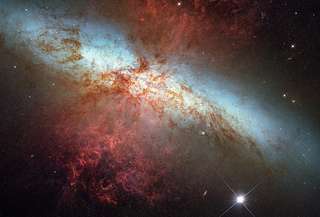Short, sharp shocks let slip the stories of supernovae

When we look up at the night sky, it's easy to feel as though the stars we see have always been, and always will be, there. But just like ourselves, stars are born and die.
And when they die, they sometimes do not go gently but end their lives in supernovae – gigantic explosions that, at their brightest, outshine entire galaxies of stars.
Supernovae bright enough to be seen with the unaided eye happen only once every few hundred years. But with modern tools and telescopes, and sometimes with the help of volunteers, we now routinely discover supernovae in faraway galaxies, such as the one pictured above, which was discovered in 2014 and is a mere 11.5 million light years away.
We've learned that supernovae differ in their colour, in the way they brighten and fade, and in the elements we find in the debris of each explosion. The grand challenge is to tell the type and prior history of the star based on its explosion – like trying to read a burnt book by watching dying embers cool in the fireplace.
A type of measure
For one kind of supernova, known as Type Ia, the stakes in this game are particularly high. Type Ia supernovae are used by astronomers to measure the distances between galaxies and the universe's expansion since the Big Bang.
They enabled us to learn in 1998 that the universe's expansion has been speeding up rather than slowing down from the gravitational pull of galaxies on each other, as physicists once expected. This observational fact is now well-established, and the 2011 Nobel Prize in Physics was awarded for its discovery. But our understanding of its physical cause is much less clear.
The search for the "dark energy" driving the universe's acceleration has driven a tremendous thirst for more precise observations of type Ia supernovae.
Dark energy is now the object of a multi-billion-dollar international research effort, spanning dozens of experiments using different methods. As scientists struggle to map the minute details of the universe's history, further progress depends in part on our trust in Type Ia supernovae as tools of the trade, and thus on our understanding of how they explode.
Explosive influence

Astronomers broadly agree, based on the elements found in Type Ia supernovae, that they are best explained by explosions of white dwarfs: ancient, shrivelled corpses of stars, with the sun's bulk condensed into a ball the size of the Earth.
But white dwarfs, once formed, will not explode by themselves. The influence of some other star is needed to trigger a supernova.
One place to look for traces of that influence is at the supernova's very beginning. If another star orbits the white dwarf, that star will be struck by the expanding shock wave from the white dwarf's explosion. The collision will release a short flash of radiation, most readily seen in ultraviolet light, which is visible for only a few days before the supernova itself outshines it.
Astronomers can tell the companion star's size from the duration of the flash. But the difficulty of finding Type Ia supernovae soon enough after explosion has until now stymied the search for companion stars.
Latest findings show different origins
Two different US-led teams have now published new results pushing the search onto new ground.
One team, led by Rob Olling at the University of Maryland, used the Kepler space telescope. Kepler has already made headlines for its discoveries of hundreds of exoplanets orbiting stars outside our solar system.
Its ability to continually watch a star or galaxy for the slightest changes make it ideal for finding supernovae within minutes after explosion.
The Maryland-led team found three Type Ia supernovae but no signs of companion stars. They argue that the companion stars in these cases must be very small – probably white dwarfs themselves. The explosion is triggered when the two white dwarfs spiral into each other and collide.
The other team, led by Yi Cao at the California Institute of Technology, used the Swift space telescope to observe supernovae immediately after their discovery.
For one supernova they did find something: a hot glow fading from view, less than four days after explosion. They argue that this is the first clear detection of a companion star that is not a white dwarf, aided by Swift's sensitivity to ultraviolet light. In this scenario, the white dwarf slowly steals gas from its companion star until reaching the critical mass for explosion.
More questions than answers
Like many important discoveries, these results raise questions as well as answering them. Both teams have done excellent work, and it now seems likely that Type Ia supernovae have companion stars of at least two types.
But how common is each type? How exactly does the companion star trigger the explosion? How can we use these results to further improve our measurements of dark energy?
With diligence and a bit of luck, we should know the answers to these questions soon.
Source: The Conversation
This story is published courtesy of The Conversation (under Creative Commons-Attribution/No derivatives).
![]()



















